Mild Unscented Soap Recipes {for sensitive skin}
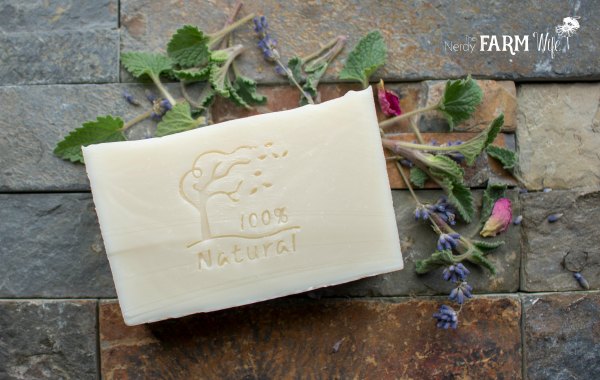
These mild unscented soap recipes are extra gentle and can be made especially for loved ones who have allergies, eczema, or are going through cancer treatments and have sensitive and more fragile skin.
The goal here is to especially avoid irritants such as fragrances, overly cleansing ingredients, or scratchy exfoliants.
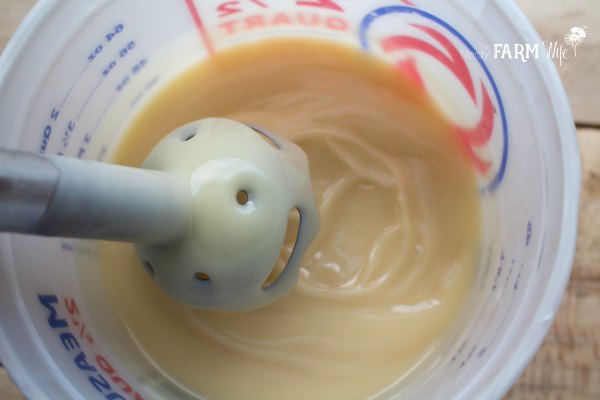
Choose a Recipe:
Extra Gentle Unscented Soap with Aloe
This soap has a mild creamy lather that won’t leave your skin feeling tight or dry. Aloe liquid (like this kind) adds an extra soothing element to the recipe, but if you don’t have any, you can use distilled water instead. You could also use milk in its place; see How to Make Soap With Milk for information on how to do that.
- 8.25 oz (234 g) aloe liquid (or distilled water)
- 3.78 oz (107 g) lye (sodium hydroxide)
- 14 oz (397 g) olive oil (50%)
- 5.04 oz (143 g) coconut oil (18%)
- 4.2 oz (119 g) sunflower or sweet almond oil (15%)
- 3.36 oz (95 g) shea, cocoa or kokum butter (12%)
- 1.4 oz (40 g) castor oil (5%)
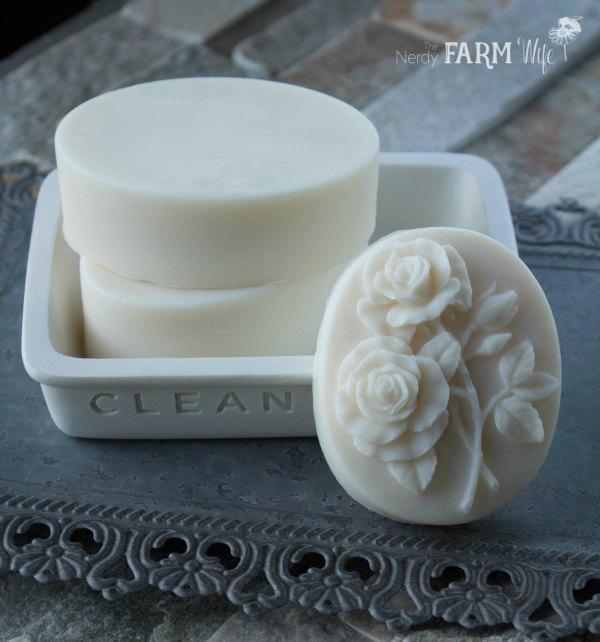
Creamy Shea Butter Unscented Bastille Soap (coconut free)
This recipe can also be found on page 33 of my Simple & Natural Soapmaking print book.
This skin nourishing soap contains a high amount of olive oil, plus shea butter for its fantastic ability to condition and moisturize skin, along with castor oil to help boost lather. As with the recipe above, you could also use aloe liquid or milk in place of the water.
- 8 oz (227 g) distilled water (or aloe liquid)
- 3.55 oz (101 g) sodium hydroxide (lye)
- 21 oz (595 g) olive oil (75%)
- 4.5 oz (128 g) shea butter (16%)
- 2.5 oz (71 g) castor oil (9%)
If shea butter isn’t available, you can substitute with mango butter, cocoa butter, lard or tallow. The lye amount will still fall within an acceptable range and will not need to be changed.
Information on the soap mold I used can be found in my 15+ Pretty Silicone Molds for Making Handmade Soap article.
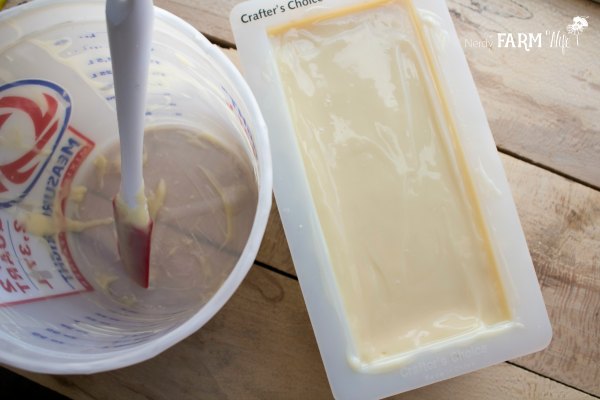
Directions to Make
- Wearing protective gloves and eyewear, carefully stir the lye into the aloe or distilled water. Avoid breathing in the temporary strong fumes.
- Set the lye solution aside in safe place to cool to around 100 to 110 degrees F (38 to 43 degrees C).
- Melt the solid oils and fats.
- Mix the melted oils/fats with the other liquid oils in the recipe.
- Pour the cooled lye solution into the warmed oils.
- Using a combination of hand-stirring and an immersion blender, stir the soap until it reaches trace*.
- Pour the soap into the mold and cover lightly with a towel or blanket.
- Keep the soap in the mold for about 2 days or until it releases easily.
- Slice into bars and cure in the open air for at least 4 weeks before use. Soaps higher in olive oil, like the bastille soap, will improve as they age, so benefit even more from a 3+ month cure time.
(*Trace is when the soap batter thickens enough so that if you drizzle some across the surface of itself, it will leave a faint design or “tracing” before sinking into the soap batter.)
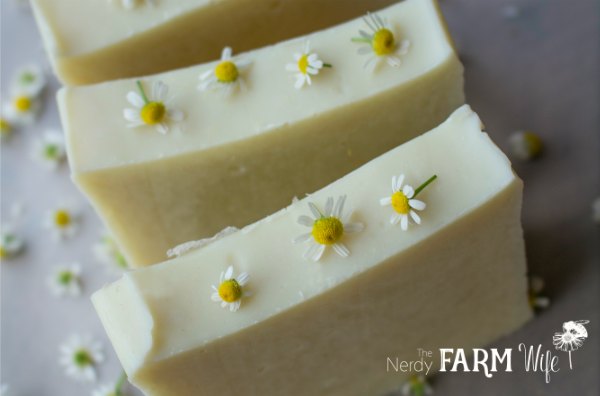
+ 3 More Recipe Ideas
Three other simple unscented soap recipes on my website include:
- Chamomile “Almost” Castile Soap – This recipe contains just two oils – olive and castor. You can omit the chamomile for a completely unscented soap.
- Oatmeal Honey Soap – This easy recipe is made in a crockpot so that it’s ready to use sooner. Omit the lavender essential oil so that it will be unscented.
- Basic Soap Recipe – You can find this simple soap recipe in my article on How to Create Custom Soaps.
For more natural soap recipes, tutorials and inspiration, be sure to check out my Natural Soap Making Ebook Collection.
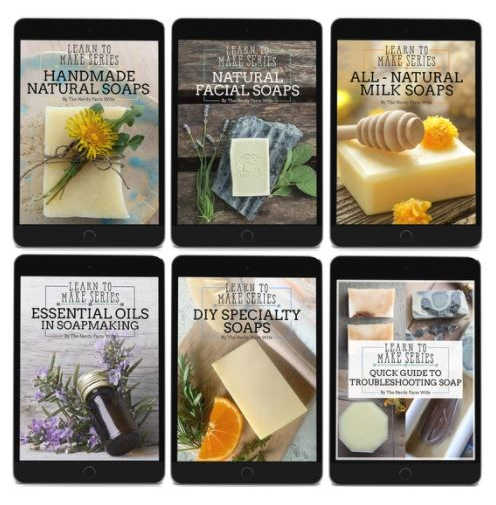
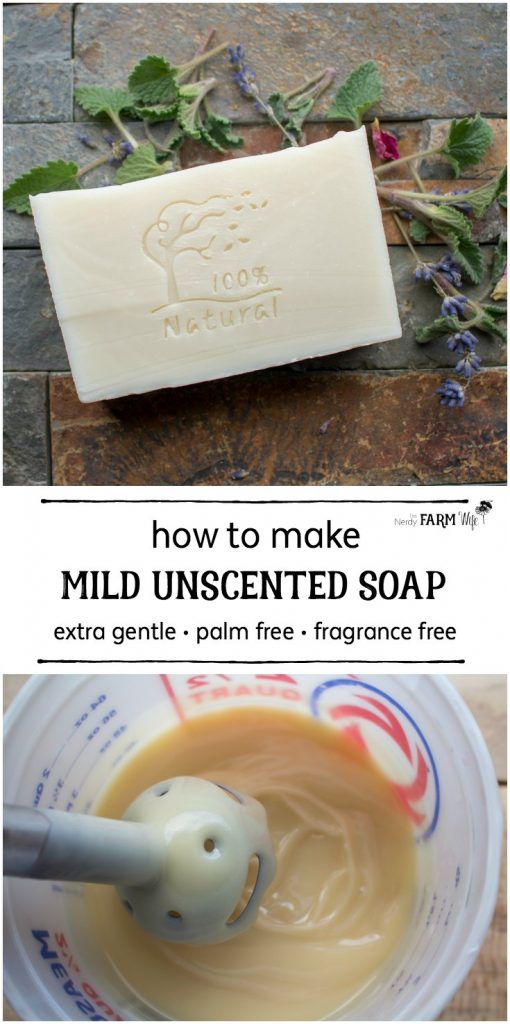

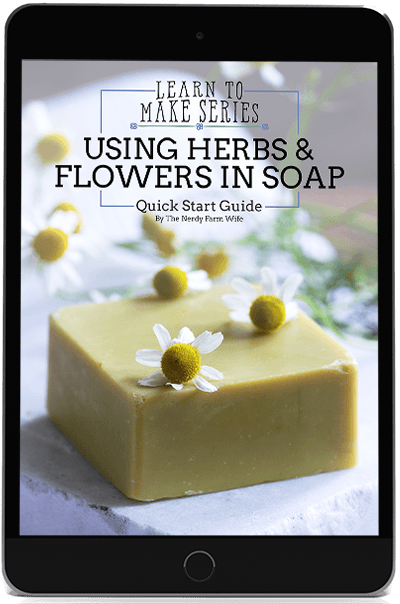

Thanks for the mild unscented soap recipes Jan. I will be making your Creamy Shea Butter recipe next. Wonderful. The Nerdy Farm Wife is still my favorate website. Keep up the wonderful posts and emails Jan, I look forward to them.
Darlene
Thank you Darlene! I appreciate the support & kind words and am so happy to hear that you enjoy the posts & emails! :)
I am enjoying your posts & recipes. I have made two other recipes from two other sites but they are not the correct ones I want. Theres nothing wrong with them but its not what I’m looking for. This recipe is completely different & I’m looking forward to making it.
Thanks for sharing
Hi Susan! I’m glad you like the recipe & hope it turns out well for you! :)
Hi! I enjoy your recipes so much! Would you please add a print option to these? Thank you!
Sorry for being so vague, just the recipe. Without the pics. Thanks!
Hi Jeannette, I’m so happy you’re enjoying the recipes! :)
To print the recipe without photos, scroll down until you see a green “Print Friendly” button. When you click on that, it will bring up the whole page, including photos.
Just use your mouse to click on anything you don’t want to print and it will disappear from the screen and won’t print out. So, that way you can only print just the text you want to save. I hope that helps, but let me know if you run into any problems with it not working correctly! :)
Aloha Jan, enjoying you and Your website all the way from Hawaii ?
Aloha Cathy! I’m so happy to hear you’re enjoying the site! :)
Hi Jan,
Thank you for the fantastic work! I’m new to soap making and live in Uganda where I do not have access to true olive oil (it’s mostly adulterated). What other oil can I substitute for olive oil?
Thank you,
Tendo
Hi Tendo! Can you let me know what other types of oils (plus fats or butters) that you have available? I’m happy to help adjust the recipe so it’s more suitable for your ingredients! :)
Is aloe liquid just aloe vera? Like the kind of gel like stuff or is this thinner? Thanks.
Hi Danielle! Aloe vera liquid is just like the gel, only it’s thinner because it doesn’t have added gums & thickeners to turn it gel-like.
It looks like this: https://www.brambleberry.com/aloe-vera-liquid-p3704.aspx
However, I’ve had several people let me know that they’ve used diluted aloe vera gel in my recipes instead of the liquid & every one of them said the soap turned out great!
So, if you don’t have access to the aloe vera liquid, you could try diluted gel instead. (I’d probably try about 50% gel & 50% water, depending on how thick the gel is.)
I made your Shea butter Castile soap and gave one to a customer of mine who is a nurse. She called back and said she LOVED it! It was like using lotion on her skin it was so lovely. Thanks for all of your great recipes!
Hi Donna, That’s wonderful to hear! I get a lot of good feedback on that recipe & I’m glad your customer enjoyed it too! :)
Thank you for all the recipes. I’ve tried many of them, and they are all great to me. I’ve tried this extra gentle soap (with water) and love the texture. I am going to try 50% aloe gel and 50% water next. Thank you again!
Hi Crystal, So happy to hear that you like the recipe! :)
How many bars does this make? I’m using the recipe for a school project and can only make one bar.
Hi December! If you make it in a loaf mold, it makes about 7 or 8 bars. You’d need to really reduce the recipe down to make just one bar – probably by around 1/8 of the amounts given.
Here’s a lye calculator that can help you figure out the exact amounts: http://soapee.com/calculator
Good luck with your school project!
Hello! Your site is AMAZING!! I was wondering what these recipes are superfatted at? :)
Thanks San! Happy to hear you’re enjoying the site! :) Most of my soap recipes are superfatted at 6%, except for soaps made with milk, tallow/lard, which are more likely to be 5%.
Jan,
Is that 5.4 oz or 5.0 oz coconut oil? Thanks.
Hi Julia! It’s 5.04 oz (143 g) which is fine to round to 5 ounces in this recipe. :)
Wanting to run these through the Soapee calculator for good form, and I don’t see in your descriptions what water discount to put in.
Hi Shirley! I calculate the water amount for my recipes mentally, but it usually lines up in Soapee or SoapCalc as about a 2.1 to 1 water to lye ratio (or a 2.2:1) water:lye ratio.
Hi,
I made this soap Creamy Shea Butter Unscented Bastille Soap (coconut free) last night and when i cut it tonight it was crumbly on the bottom. I googled why and it said that it was lye heavy. Ill cure it and then check it. Is there a reason this might have happened. This is only my second soap. Thanks ! I cant wait to get your book.
Hi Julie, I’m sorry to hear that happened! Crumbly soap is often associated with too much lye.
Just to double check – are you using an accurate scale to weigh your oils, lye, and liquids?
Sometimes new soapmakers use measuring cups and that can skew things the wrong way, so I always like to ask first! :)
If you did use an accurate scale and you know you weighed everything correctly, then it could be a mixing or temperature problem.
Sometimes you can reach a false trace – where it looks like you reached trace stage, but it’s just because the soap batter cooled down & made the solid fats (like butters, coconut oil, tallow, lard) start hardening up too soon.
When they cool and harden, then your soap batter looks thick, but it’s not really at trace.
Do you remember what temperature your oils and lye solution were at when you mixed? Or were you working in a really cold room? Or did you refrigerate the soap?
What kind of appliance did you use for mixing?
I have a troubleshooting article:
https://thenerdyfarmwife.com/troubleshooting-cold-process-soap-problems/
You can also send photos and more details to us – hello @ thenerdyfarmwife . com and we can help troubleshoot further. :)
Hi, I used an accurate scale. As i am reading thru your reply, i forgot to check the temperature of the lye and oil.
It looks exactly like the top photo of (What’s Wrong With My Soap? {troubleshooting cold process soap problems). What can i do with the soap, is it salvageable or can i use if for laundry?
Thanks :)
Hi Julie! Since you used the accurate amount of lye and oils, then the overall soap itself should be safe to use – however, the crumbling could mean that the bottom crumbly parts are lye heavy, while the top parts don’t have enough lye.
You have a few options:
1. Go ahead and give your soap the “zap test” – this is where you lightly touch your tongue to a soap that you’re unsure of and see what happens.
In this case, you would zap test a crumbly part, then you would zap test a part that looks okay.
If you feel a zappy jolt, like you licked a 9 volt battery (not that people commonly do that to compare!) :) – then it’s lye heavy.
If it just tastes gross, like you licked a bar of soap – then it should be fine to uses.
If the crumbly part “zaps” and the normal part doesn’t, then you need to rebatch your soap.
2. Let your soap cure for at least 4 to 6 weeks, then see if it zaps.
3. You could go ahead and rebatch this soap, and then you know for sure that the lye would be evenly distributed throughout and is safe to use.
Thanks !